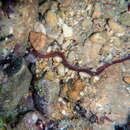Comprehensive Description
(
anglais
)
fourni par Smithsonian Contributions to Zoology
Eunice torquata Quatrefages, 1866
Eunice torquata Quatrefages, 1866:312–313, pl. 10.
MATERIAL EXAMINED.—?Holotype, MNHN, Paris, A.1(R.)–1868-no. 47a, St-Jean-de-Luz, coll. Quatrefages.
DESCRIPTION.—Specimen incomplete with 120 setigers; length 97 mm; maximal width 4 mm; length through setiger 10, 10.5 mm. Body cylindrical throughout with well-defined segments.
Prostomium (Figure 109a) distinctly shorter and narrower than peristomium, as deep as of peristomium. Prostomial lobes frontally rounded, dorsally inflated; median sulcus deep. Eyes between bases of A-I and A-II, faded, hidden below peristomial fold. Antennae in a horseshoe, evenly spaced, similar in thickness. Ceratophores ring-shaped in all antennae, without articulations. Ceratostyles tapering, with up to 14 moniliform articulations in A-III. First articulation of ceratostyle long and cylindrical. A-I to posterior peristomial ring; A-II to setiger 1; A-III to setiger 2. Peristomium cylindrical. Separation between rings distinct dorsally and ventrally; anterior ring of total peristomial length. Peristomial cirri to middle of anterior peristomial ring, tapering, with 4 long, cylindrical or drop-shaped articulations.
Jaws not examined.
Branchiae present, pectinate, distinctly longer than notopodial cirri, not reduced in mid-body region, erect. Branchiae from setiger 3 through end of fragment. All branchiae with 2 or more filaments; maximum number of filaments 7 at about setiger 15. Posterior to setiger 30 most branchiae with 2 or 3 filaments (Figure 109b). Branchial stems short, tapering. Filaments short, digitiform.
Anterior neuropodial acicular lobes distally truncate; median and posterior acicular lobes distinctly more rounded; aciculae emerging at midline. Pre- and postsetal lobes low, transverse folds. First 4 ventral cirri thick, tapering; ventral cirri with indistinctly inflated bases between setigers 5 and 30. Inflated bases ovate; narrow tips tapering. Posterior ventral cirri thick and tapering shape. Notopodial cirri basally slightly inflated, tapering. Anterior notopodial cirri with up to 5 distinct, long articulations; posterior notopodial cirri with 3 articulations.
Limbate setae marginally smooth. Pectinate setae (Figure 108d) narrow, tapering, flat. One marginal tooth longer than other teeth; ∼12 teeth present. Shafts of compound falcigers (Figure 109c) tapering, marginally indistinctly serrated. Appendages short, nearly triangular, bidentate. Proximal teeth smaller than distal teeth, reduced triangular, sharp-tipped, directed laterally. Distal teeth thick, blunt, curved. Guards asymmetrically bluntly pointed, marginally smooth; mucros absent. Pseudocompound falcigers and compound spinigers absent. Aciculae (Figure 109f) paired, chestnut-brown, tapering, slightly curved dorsally; cross-sections round. Separation between core and sheath distinct in both aciculae and subacicular hooks. Subacicular hooks (Figure 109e) with chestnut-brown shafts up through neck and clear heads, bidentate. Hooks first present from setiger 32, present in all setigers thereafter, paired in some setigers. Hooks tapering to narrow necks; heads small. Proximal teeth larger than distal teeth, directed obliquely distally. Distal tooth blunt, directed obliquely distally. Guards blunt.
UNKNOWN MORPHOLOGICAL FEATURES.—Jaw structure; pygidium and anal cirri.
EXPECTED STATES OF UNKNOWN MORPHOLOGICAL FEATURES.—Mx III short; forming part of distal arc with left Mx IV.
CHARACTERS USED IN PREPARATION OF KEY NOT SCORED.—Inappropriate Characters: 56, 58, 59. Unknown Characters: 1, 2,4, 6, 36–38, 40.
ASSUMED STATES FOR PURPOSE OF PREPARING KEY—37,1; 38,1.
- citation bibliographique
- Fauchald, Kristian. 1992. "A Review of the Genus Eunice (Polychaeta: Eunicidae) Based upon Type Material." Smithsonian Contributions to Zoology. 1-422. https://doi.org/10.5479/si.00810282.523

